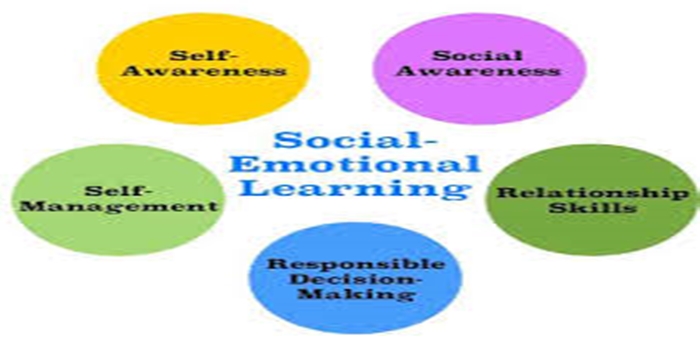In this article, we discussed the meaning of social and emotional learning, the features, the importance, and How SEL is Implemented in Schools.
Definition
Social-Emotional learning (SEL) is the process of developing and applying the knowledge, skills, and attitudes needed to understand and manage emotions, build healthy relationships, and make responsible decisions. It’s about learning to recognize and manage emotions, develop care and concern for others, and navigate social situations effectively.
The Features of Social and Emotional Learning:
Elaboration:
Self-awareness:
This involves recognizing one’s own emotions, thoughts, and values, as well as understanding how they impact behavior.
Self-management:
This refers to the ability to regulate emotions, manage stress, and make responsible choices to achieve goals.
Social awareness:
This involves understanding the emotions, perspectives, and cultural differences of others.
Relationship skills:
This includes the ability to build and maintain healthy relationships, communicate effectively, and resolve conflicts constructively.
Responsible decision-making:
This encompasses making ethical and thoughtful choices that consider both personal and social consequences.
SEL aims to equip individuals with the skills to navigate complex social situations, manage emotions effectively, and build positive relationships, ultimately leading to improved well-being and success in various aspects of life.
Benefits of SEL in Schools:
Improved Academic Performance:
Students who participate in SEL programs tend to show an increase in overall grades and improved attendance.
Enhanced Mental Health:
SEL helps students develop coping skills, resilience, and the ability to manage stress, potentially reducing symptoms of depression and anxiety.
Stronger Relationships:
SEL fosters empathy, compassion, and the ability to understand and connect with others, leading to positive social interactions and a sense of belonging.
Reduced Behavioral Issues:
By promoting self-awareness, self-regulation, and responsible decision-making, SEL can help reduce instances of bullying, aggression, and other behavioral problems.
Increased Empathy and Compassion:
SEL helps students understand and share the feelings of others, fostering empathy and a sense of caring for their peers.
Improved Decision-Making:
SEL equips students with the skills to evaluate situations, consider consequences, and make responsible choices.
Greater Self-Awareness and Self-Management:
SEL helps students understand their own emotions, thoughts, and values, and develop strategies to manage them effectively.
How SEL is Implemented in Schools:
Structured Programs:
Some schools implement comprehensive SEL programs that integrate into the curriculum and are taught by classroom teachers.
Classroom Discussions:
SEL can be integrated into daily classroom activities, such as discussions about emotions, social interactions, and problem-solving.
Activities and Exercises:
Schools may use activities, games, and simulations to teach and practice SEL skills.
Teacher Training:
Educators often receive training on SEL principles and strategies to effectively incorporate SEL into their teaching.
By prioritizing SEL, schools can create a more positive, supportive, and engaging learning environment that benefits students academically, emotionally, and socially.
How SEL is implemented:
- Explicit SEL Instruction:
Curriculum Integration:
SEL can be woven into existing subjects, like literature, history, or math, through activities that promote teamwork, empathy, and problem-solving.
Dedicated SEL Lessons:
Some schools dedicate specific time slots in the day, like homeroom, for explicit SEL instruction.
Age-Appropriate Units:
SEL lessons are designed to be age-appropriate and build upon each other, starting with foundational concepts in early childhood and progressing to more advanced topics.
Teacher Training:
Teachers receive training to incorporate SEL effectively into their teaching methods.
- Creating a Supportive School Climate:
Positive Relationships:
Fostering positive teacher-student relationships and a welcoming classroom environment is crucial.
Student Voice and Engagement:
Involving students in the SEL process, such as through student-led initiatives or feedback, can be beneficial.
Family and Community Partnerships:
Engaging families and community members in the SEL journey can create a more holistic support system for students.
- Assessing SEL Effectiveness:
Multiple Assessment Methods: SEL is assessed using a variety of methods, including questionnaires, observations, performance assessments, and interviews.
Tracking Progress: Regularly assessing student progress helps educators understand what’s working and what needs adjustments.
Continuous Improvement: Data from assessments is used to inform and improve SEL programs.
- Key Strategies for Effective SEL Implementation:
Establish an SEL Team:
A dedicated team can help guide the implementation process and ensure that SEL is integrated into all aspects of school life.
Ongoing Support:
Providing ongoing coaching, support, and feedback to teachers is essential for sustaining SEL implementation.
Focus on Adult SEL:
Schools also need to prioritize the social-emotional well-being of their staff, as their own well-being can impact students.
By implementing a comprehensive and holistic approach to SEL, schools can help students develop the social and emotional skills they need to succeed both in school and in life.
Conclusion
Social-Emotional Learning (SEL) concludes as a crucial component of modern education, fostering a more compassionate, healthy, and successful society by equipping students with essential skills to navigate life’s challenges. It’s not just beneficial; it’s essential for preparing students for the complexities of the future. By embracing SEL, schools can develop well-rounded, emotionally intelligent individuals.
READ: Special Education and Inclusive Learning Strategies

